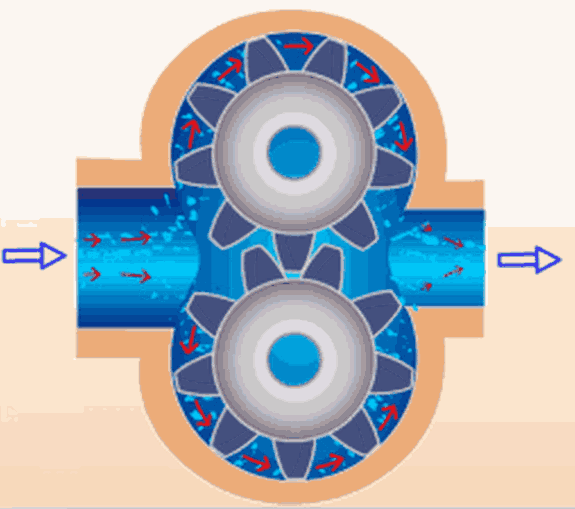In hydraulic systems—whether on excavators, tractors, forklifts, forestry machines, industrial presses, or any heavy-duty equipment—the hydraulic pump is the heart of the entire system. It draws oil from the reservoir, pressurizes it, and then sends it to cylinders, motors, and valves to perform work.
If you look closely at more than 90% of hydraulic pumps on the market, you will notice a common structural feature:
The inlet port is much larger than the outlet port.
This is not accidental. It is the result of decades of engineering experience, fluid dynamics principles, and countless tests in real applications. In this article, we will explain in detail why hydraulic pumps are almost always designed with a large inlet and a small outlet, and why this design is crucial for reliability, stability, and efficiency.

1. Understanding the Pump’s Operation: Why “Suction” Is More Difficult Than “Pressurization”
A hydraulic pump performs two main actions:
Suction – drawing oil from the tank
Discharge – pressurizing the oil and delivering it to the system
Although “pressurization” looks like the main job of a pump, in engineering practice, the suction process is actually more challenging. If the pump cannot draw oil in smoothly, everything else fails.
A poor suction condition leads directly to the most destructive phenomenon in hydraulic pumps:
2. The Main Reason the Inlet Is Larger: Preventing Cavitation
What is cavitation and why is it dangerous?
Cavitation occurs when the pressure at the pump inlet drops so low that dissolved air in the oil forms bubbles. These bubbles then collapse violently when they reach the high-pressure zone inside the pump.
The effects include:
Erosion of metal surfaces (pitting)
Noise and vibration
Sharp drop in pump efficiency
Heat increase
Severe cases: complete pump failure
In short, cavitation is like “heart tissue damage” for the pump—irreversible and extremely harmful.
And the most common trigger?
A small inlet port causing excessive suction resistance.

3. Why a Larger Inlet Prevents Cavitation
1. Reduced suction resistance
A large inlet gives the oil enough cross-sectional area to enter the pump at low velocity, minimizing pressure drop.
2. Preventing excessive negative pressure
If the oil velocity becomes too high due to a small inlet, the pressure can drop below the vapor pressure of the oil, creating bubbles → cavitation.
A larger inlet stabilizes inlet pressure and avoids sudden pressure drops.
3. High-viscosity oils require larger inlets
Many hydraulic systems use high-viscosity oils (e.g., ISO VG 46, VG 68).
High viscosity = greater resistance to flow = higher chance of inlet pressure loss.
Therefore, a larger inlet is especially important for heavy-duty hydraulic systems.
4. Why Is the Outlet Smaller? Pressurized Oil Behaves Differently
Once the pump finishes drawing oil in, the oil is pressurized to:
At this stage, the oil flow is already high-pressure and high-energy, and behaves very differently compared to the suction side.
1. A smaller outlet helps maintain pressure
Just like squeezing the end of a garden hose will increase the water jet distance, a smaller outlet:
This helps the pump maintain a steady pressure supply to the hydraulic system.
2. There is no risk of “failing to push oil out”
Unlike suction, where negative pressure is needed:
The discharge side is always under positive pressure
The pump mechanically forces the oil out
No cavitation occurs on the outlet side
Thus, a large outlet is unnecessary and may even reduce efficiency.
3. Smaller outlets handle high pressure better
A smaller diameter outlet:
Allows thicker walls
Improves structural strength
Reduces stress concentration
Handles high pressure more safely
This is crucial for pumps working under heavy loads.

5. Fluid Dynamics Explanation: The Continuity Equation
Hydraulic pump inlet and outlet flow must satisfy the continuity equation:
Q = A × v
(Flow rate = Area × Velocity)
Since pump flow rate is constant, inlet and outlet must satisfy this relationship:
At the inlet:
Large area (A) → lower velocity (v)
→ stable pressure, reduced cavitation risk
At the outlet:
Smaller area (A) → higher velocity (v)
→ concentrated pressure, stable discharge
This formula perfectly explains the “large inlet, small outlet” design rule.
6. Are All Hydraulic Pumps Designed This Way?
Not all—but over 90% of single-direction pumps follow this rule.
Exceptions include:
1. Bi-directional pumps
Inlet and outlet need to interchange roles, so they are the same size.
2. Special design pumps
Some pumps have equal port sizes due to installation or piping requirements.
3. Very small displacement high-pressure pumps
Their inlet flow requirement is small, so port size difference is not obvious.
But for most vane pumps, gear pumps, piston pumps, and industrial hydraulic pumps, “large inlet, small outlet” is the standard.
7. Why Engineers Treat This Design as a “Golden Rule”
Because it solves two biggest engineering concerns:
1. Preventing cavitation → Protecting the pump’s lifespan
A large inlet is the most effective way to reduce risk of cavitation damage.
2. Ensuring stable high-pressure output
A smaller outlet increases efficiency and stabilizes the output flow.
3. Optimal structural strength
Small outlets withstand high pressure more easily and safely.
This design is not just a habit—it is the result of combining fluid dynamics, material science, and decades of field experience.
8. Conclusion: The Large-Inlet, Small-Outlet Principle Is Engineering Wisdom
To summarize the entire concept in two simple lines:
A large inlet ensures easy suction and prevents cavitation.
A small outlet stabilizes pressure and reduces energy loss.
This design reflects:
Fluid mechanics principles
Practical engineering requirements
Pump durability considerations
Decades of hydraulic industry experience
Understanding this principle gives you a deeper insight into hydraulic pump design and the core logic of hydraulic systems.


























